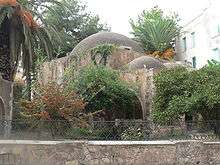Kara Musa Pasha
Kara Musa Pasha (Bosnian: Kara Musa Paša; also known as Kapıcıbaşı Musa Pasha; died 1649)[1] was an Ottoman soldier and statesman of Bosniak origin who was named grand vizier by sultan Ibrahim I 16 September 1647 after Nevesinli Salih Pasha's execution, holding the office for only five days until 21 September. He also held the office of Kapudan Pasha (Grand Admiral of the Ottoman Navy) in 1647.[1]
Musa was born in the village of Vikoča in the vicinity of Foča, in the Sanjak of Bosnia. He was born to the family of Vehabegović. His first meeting with sultan Murad IV was in 1630. Later on in his life, he became a member of Sublime Porte/Divan (the Ottoman government council) and was selected three times to serve as deputy of the Budin Eyalet. There in 1643, he received an endowment for the construction of the Musa-Pasha Mosque in Nova Kasaba, Bosnia and Herzegovina. During the Crete war campaign, after the death of the previous incumbent Koca Musa Pasha, Kara Musa Pasha received the title of Kapudan Pasha in 1647.[1] When he invaded the city of Rethymno in Crete, he had a church there converted into a mosque, which still stands as "Kara Musa Pasha Mosque." However, because of lack of many successes, he was dismissed from the role of Kapudan Pasha soon afterwards.
Also while he was fighting in the war, the imperial seal signifying his promotion to grand vizier was sent to him by sea. After having received the news of his promotion, but not having yet received the seal, he was passed over for grand vizier because of the influence of Hezarpare Ahmet Pasha over the sultan, who instead chose Hezarpare Ahmet Pasha as grand vizier.[1]
In the beginning of the same year of 1647, he had married Şekerpare Hatun,[1] a lady in waiting and a favorite of the sultan, which was the very reason for his appointment as Grand Admiral.[2]
In December 1647, Kara Musa Pasha was made the governor of Baghdad Eyalet. He held this post for just over a year until January 1649, when he was dismissed and returned to Constantinople. He was executed sometime that year[1] on the orders of queen regent Kösem Sultan, in turn upon the advice of her advisers and grand vizier.
See also
Footnotes
- 1 2 3 4 5 6 Süreyya, Bey Mehmet, Nuri Akbayar, and Seyit Ali. Kahraman. Sicill-i Osmanî. Beşiktaş, İstanbul: Kültür Bakanlığı Ile Türkiye Ekonomik Ve Toplumsal Tarih Vakfı'nın Ortak Yayınıdır, 1890. Print.
- ↑ "Şekerpare Hatun" (in Turkish). Ottoman Bank Archives.
| Political offices | ||
|---|---|---|
| Preceded by Nevesinli Salih Pasha |
Grand Vizier of the Ottoman Empire 16 September 1647 - 21 September 1647 |
Succeeded by Hezarpare Ahmed Pasha |
| ||||||||||
